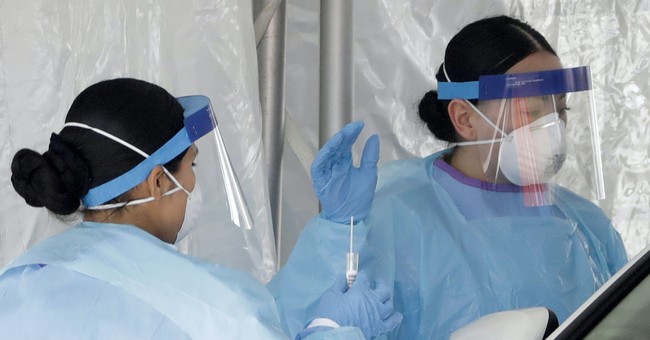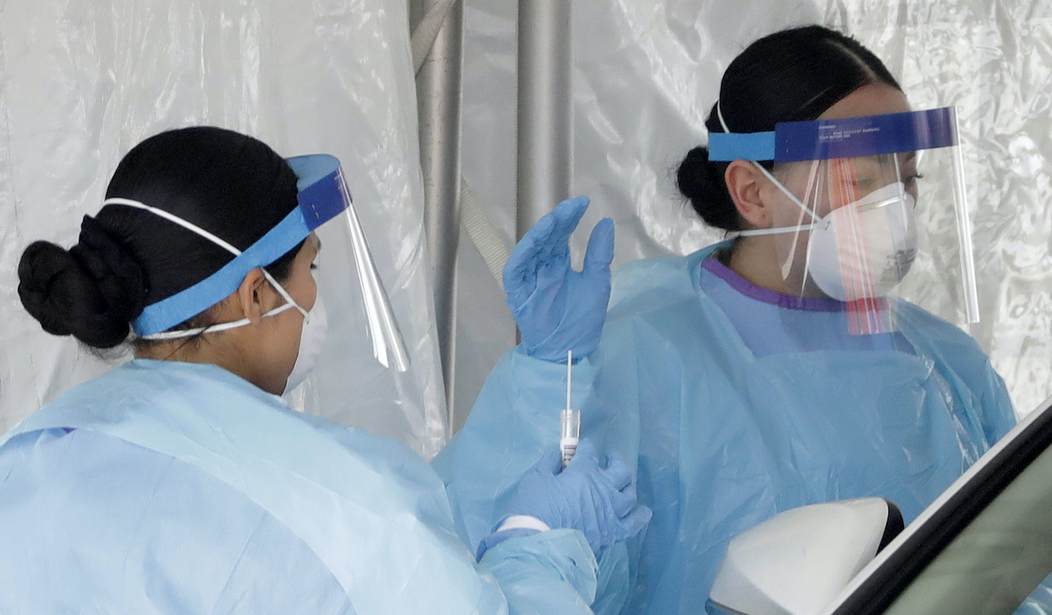
Medical staff in protective gear administer a test for COVID-19 at a drive-through testing center in Paramus, N.J., Friday, March 20, 2020. The coronavirus testing center opened Friday in Bergen County which has been the state’s hardest-hit area. Gov. Phil Murphy said only those with symptoms should get in line, and not those whom he called the “worried well,” people who are feeling well but are concerned they could be infected. The facility will have the capacity to conduct 2,500 tests a week, according to the governor. (AP Photo/Seth Wenig)
The first diagnosis of the Wuhan Virus occurred in Snohomish County, Washington, on January 19, when a 35-year-old man presented with a four-day cough history at a local urgent care facility. He had returned from visiting family back in Wuhan, China. From there, the number of cases grew slowly, but steadily, boosted by a group of cases at the Life Care Center (nursing home in Kirkland, WA). Over 30 patients at this facility have since died from the virus. As the virus continued to spread, the numbers began to increase faster. After March 8, the number of new cases from one day to the next averaged about 50 percent. For example, if there were 500 new cases one day, there would be roughly 750 the following day.
There are signs this rapid pace may be slowing, thus “flattening” the curve. We want to see the ratio of the number of new confirmed cases to the total cases approach zero.
Hotair’s Allahpundit posted on Seattle’s curve on Thursday. While it’s much too early to call this a trend, I checked Friday’s statistics which showed 189 new cases, an increase of only 16% from the day before.
According to USA Today, nationwide, the U.S. first entered into the “community transmission” phase on March 3, so we are now more than two weeks into it. Washington State is ahead of the rest of the country. The state had the earliest outbreaks and can be expected to emerge from it first.
New Cases of Wuhan Virus in Washington State
Source: Seattle Times
Total Cases New Increase
2/28: 1
2/29: 7 +6 600%
3/2: 18 +11 157%
3/4: 39 +21 117%
3/6: 83 +44 113%
3/8: 137 +54 65%
3/10: 267 +130 95%
3/12: 457 +190 71%
3/14: 642 +185 40%
3/16: 904 +282 44%
3/18: 1,187 +283 31%
3/19: 1,376 +189 16%
Nate Silver, the editor of FiveThirtyEight and a political statistician, saw a similar trend in King County, WA (Seattle). He noted that “based on restaurant reservation data—widespread social distancing took place sooner there than elsewhere. So combined with relatively good testing, it’s where we might hope to see the curve bending first.”
Finally, Silver said that major employers in Seattle were also well ahead of the rest of the country in asking employees to work from home. That both helps with social distancing and serves as a signal to people that it’s not business-as-usual.
The other lesson from Seattle is that—based on e.g. restaurant reservation data—widespread social distancing took place sooner there than elsewhere. So combined with relatively good testing, it's where we might hope to see the curve bending first.
https://t.co/KWA3ItuZTh— Nate Silver (@NateSilver538) March 19, 2020
CNBC offered a pretty good explanation for why we should work toward flattening the curve.
In epidemiology, the curve refers to the projected number of new cases over a period of time.
In contrast to a steep rise of coronavirus infections, a more gradual uptick of cases will see the same number of people get infected, but without overburdening the health-care system at any one time.
The idea of flattening the curve is to stagger the number of new cases over a longer period, so that people have better access to care.
I can certainly understand the logic in that. But if the same number of people will be infected, the more impulsive part of me just wants to “get it done.” Give me the steep rise and fall.
Nevertheless, here we all are.
What everyone seems to agree on is the need for widespread testing. In early March, Seattle researcher Trevor Bedford “detected the hidden community spread in his city via genetic analysis.”
In the text message thread below, Bedford suggests a plan for communities to follow, with “massive testing” being the cornerstone.
This rollout of testing could be achieved through at home delivery of swabs with centralized lab-based processing combined with drive-through testing facilities. There are logistics involved in getting a result quickly, but it's really just logistics, which can be solved. 14/19
— Trevor Bedford (@trvrb) March 19, 2020
This strategy targets testing capacity at most likely cases and serves to detect exposure events early, when isolation is most valuable. This cell phone location based approach is outlined carefully here: https://t.co/cu09jbd6zB. 16/19
— Trevor Bedford (@trvrb) March 19, 2020
Individuals who have serological evidence of recovery and are no longer shedding virus can fully return to the workforce and keep society functioning (especially important for those at the clinical front lines). 18/19
— Trevor Bedford (@trvrb) March 19, 2020
See, that’s all we need to do.













Join the conversation as a VIP Member